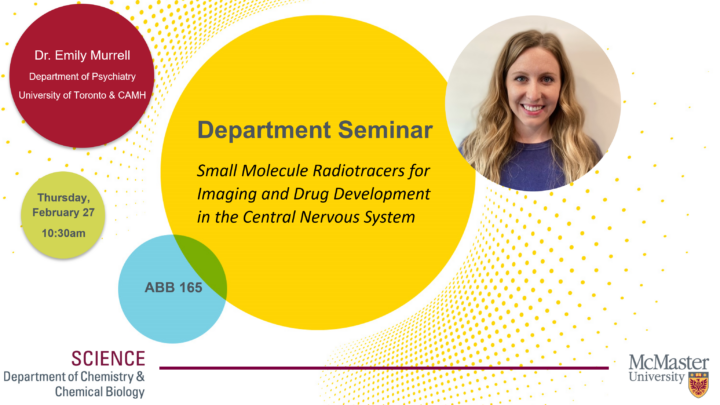Department Seminar: Dr. Emily Murell
Feb 27, 2025
1:30PM to 2:20PM

Date/Time
Date(s) - 27/02/2025
1:30 pm - 2:20 pm
Title: Small Molecule Radiotracers for Imaging and Drug Development in the Central Nervous System
Date: Thursday February 27, 2025
Time: 1:30-2:20pm
Room: ABB 165
Host: Dr. James Inkster
Abstract:
Positron emission tomography (PET) imaging is a useful neuroimaging tool because it allows for quantitative and non-invasive visualization of biological targets at sub-pharmacological doses of a given compound. Development of successful PET radiotracers for the central nervous system (CNS) depends on many factors such as brain permeability, affinity and specificity of the compound to its target, and the pharmacokinetics of the radiotracer. My research program focuses on the medicinal chemistry, radiolabelling, and preclinical evaluation of new radiotracers for PET imaging in the CNS for the purpose of either (1) imaging molecular targets of interest for various neurological indications or (2) evaluation of CNS drug candidates. This seminar will present both the bench-to-bedside development of [18F]OXD-2314, a radioligand for imaging the protein tau in neurodegenerative disease, along with preclinical evaluation of radiotracers targeting ALK2 to support drug discovery for DIPG, a rare pediatric brainstem cancer.
Biography:
Dr. Emily Murrell is a Staff Scientist with the Brain Health Imaging Centre at the Centre for Addiction and Mental Health (CAMH) and an Assistant Professor in the Department of Psychiatry at the University of Toronto. She received her BSc in Chemistry at Dalhousie University, followed by a PhD at the University of Western Ontario with Prof. Len Luyt developing peptide-based imaging agents for oncology targets, and a postdoctoral fellowship at CAMH with Prof. Neil Vasdev on carbon-11 and fluorine-18 radiolabelling of small molecule radiotracers for neuroimaging. She then joined Bristol Myers Squibb as a radiochemist for two years, where she developed radiotracers for use in CNS drug discovery before returning to CAMH in 2023.
